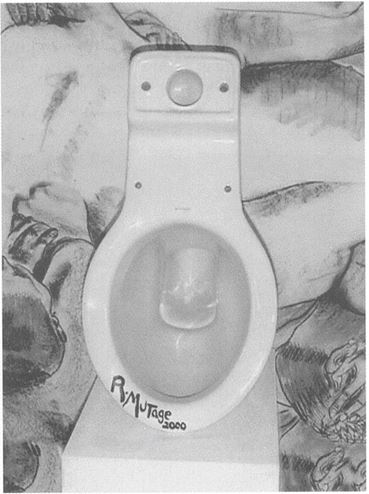
When is Art?
Harvesting bewilderment: from crap to conversation written by freelance curator, arts writer and educator Jane Deeth, was originally published in the Australian and New Zealand Journal of Art, Vol 2, 2001 – Issue 1, ‘the real millennium issue’, and has been available on-line since May, 2015. The article is about the exhibition When is Art? exhibited in Gallery A at the Northern Campus of the University of Tasmania in Launceston, when Jane was the Gallery Director. It was a directors pick, really:

When I conceived this website something whispered – make sure there is a place for a gallery, an homage to past art practice, so I’m raking up the traces. When is Art? was a good opportunity to work with Jane on a curator’s concept. It gave me such grief, wondering how to recreate Duchamp’s Fountain, and after considerable research everything seemed apparent. This was the fantastic twentieth century challenge, redefining what art is or can be. We are in the midst of another, after the launch of ChatGPT in November last. Watch that space if you have a lot of time to kill, and want to explore the concept, or make art generated by artificial intelligence. Duchamp has already said it all I reckon. This had to be a found object of course, a piss-take, literally. Then my find at the fabulous tip shop at Invermay, the Armitage toilet. In 1917 Fountain was signed by R. Mutt, delivered to the New York Independents, rejected and never exhibited in public, surviving as an image taken by photographer Alfred Stieglitz. Fountain was re-created much later, not in porcelain, but earthenware, glazed white, a legitimate fake for the Tate, along with seven others, acquired by various institutions. Duchamp authorised the edition as his moment took flight in 20th century art. And so much has been written and re-interpreted since, by artists, theorists, journalists and writers.
I’m adding some now. My Fountain survives as an image, after being carted around through a few impoverished house moves, and eventually joined the hard rubbish. Stieglitz may have tossed out the original in a similar way. My Fountain photo was posed: taken by artist and art lecturer Christl Berg. The sculpture is in the foreground, in front of a large charcoal life-drawing. Stieglitz took the original, back-grounded by The Warriors by artist Marsden Hartley. Life drawing still intoxicates and challenges me, and it seemed cheekily good then, to insert something of mine behind the image of the readymade sculpture. The brief was to recreate the difficult moment, so the photograph joined the show, tacked to the wall behind the object. Throughout the exhibition, the curator engaged in a conversation with the gallery visitors, via a series of cards lining the walls. I’m sharing some memories here, fondly, and started digging into the hidden tub, stored in a cupboard.

I’ve unearthed a pile of covers, and the beautifully put together exhibition catalogue. There are five artists, five artist statements and five essays, with an introduction by Jane. In a twist of fame/fate R. Mutage (the artist formally known as Kim) weighed in on the cover of the Journal, side by side with the advertised Monet blockbuster, at the National Gallery of Australia. I was so busy surviving at the time, it is only now, thinking about this deep forage into the archive box, that I realize that life could have taken a different tack. I think the cover was a bit controversial at the time, but that’s memory. Lets just say it was. I’m definitely taking a copy of that cover to the framers on Tuesday.

#duchamp, #duchampfountain, #readymadeart, #lifedrawing,

